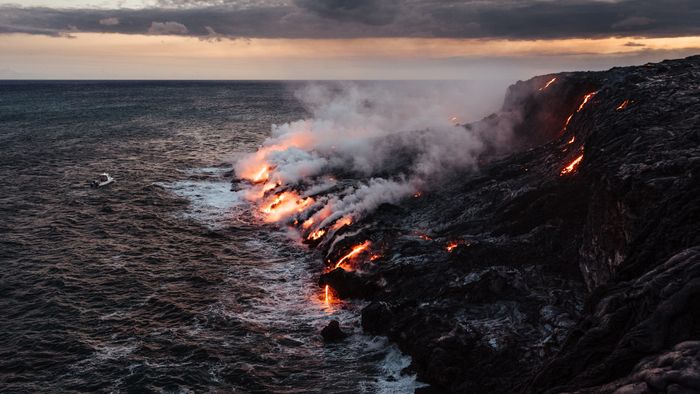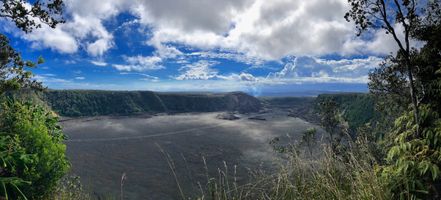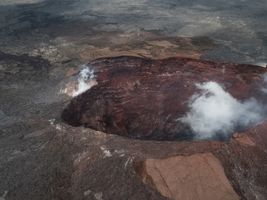Hawaiʻi Volcanoes National Park - map, photos and other informations
Table of Contents
Description
Hawaiʻi Volcanoes National Park is a United States National Park located in the U.S. state of Hawaii on the island of Hawaii. The park encompasses two active volcanoes, Kīlauea and Mauna Loa, and offers visitors an opportunity to explore volcanically formed landscapes, including lava fields and craters. Established in 1916, it is the largest national park in the United States.
The main attraction of the park is the awe-inspiring activity of the two volcanoes. Kīlauea is the world's most continuously active volcano, and Mauna Loa is the world's largest shield volcano. Both volcanoes offer visitors a chance to witness their powerful and dynamic force, whether it is through steaming sulfur vents or periodic eruptions. The park offers a variety of hikes, backcountry adventures, and other activities such as ranger-led programs and guided tours.
The park is also home to a variety of unique wildlife, including native birds, plants, and insects. Visitors can see ohi'a and ōhia lehua trees, hapuu ferns, lygodium palms, and endangered Hawaiian plants such as the native red Silversword. There are also rare and endangered animals in the park, such as the nene, a native Hawaiian goose, and the Hawaiian hoary bat.
Hawaiʻi Volcanoes National Park covers 333,086 acres and stretches from sea level to the summit of Mauna Loa, the world's tallest mountain. The park itself is comprised of five separate areas, all of which are open for exploration and recreation. The main area of the park is located in the Kaumana Caves area, where Kīlauea and Mauna Loa can be seen. Here visitors can explore the Thurston Lava Tube, take a self-guided tour of the Kilauea Iki Crater, and hike along the many trails the park has to offer. Other areas include the Chain of Craters Road, a visitors center, the Thurston Lava Tube, the Puna Coast, and the Mauna Loa Volcano.
The establishment of the park began with a bill that was introduced in 1915 by the then-governor of Hawaii Walter F. Frear. The bill passed, and the park was officially established on August 1, 1916, becoming the 11th national park in the United States. Since then, more land has been added to the park, and today it is one of the most visited sites in the state of Hawaii.
The park is open year-round and offers a variety of activities for visitors, including guided hikes, self-guided hikes, horseback riding, and camping. There are also educational programs and ranger-led activities available. The park offers something for every type of traveler, whether it is an experienced hiker or a first-time visitor.
Photos of Hawaiʻi Volcanoes National Park
Frequently Asked Questions (FAQ) about Hawaiʻi Volcanoes National Park
Where is Hawaiʻi Volcanoes National Park located?
Hawaiʻi Volcanoes National Park is located on the island of Hawaii, about 45 miles southwest of Hilo, 90 miles from Kailua-Kona, and 150 miles from Honolulu.
How many volcanoes are in Hawaiʻi Volcanoes National Park?
There are two active volcanoes in Hawaiʻi Volcanoes National Park, Kīlauea and Mauna Loa, and one inactive volcano, Mauna Kea.
Can you see lava at Hawaiʻi Volcanoes National Park?
Yes, you can see lava at Hawaiʻi Volcanoes National Park. The park is home to two of the world's most active volcanoes, Kīlauea and Mauna Loa. Visitors can often witness lava flows and other volcanic activity in the park.
Is it safe to visit Hawaiʻi Volcanoes National Park?
Yes, Hawaiʻi Volcanoes National Park is safe to visit. However, visitors should use caution and be aware of any potential risks associated with being in a volcanic area. Visitors should also follow all safety instructions and guidelines provided by the park staff.
What is the climate of Hawaiʻi Volcanoes National Park?
Hawaii Volcanoes National Park has a tropical rainforest climate. It is characterized by warm, wet winters and hot, dry summers. The park receives an average of about 128 inches (3,250 mm) of rain per year. The temperature can reach as low as 49°F (9.4°C) at night and as high as 85°F (29.4°C) during the day.
Average weather in Hawaiʻi Volcanoes National Park
|
|
|
|
|
|
|---|---|---|---|---|
| Jan | 19 °C 66 °F | 15 °C 59 °F | 66 mm 2.6 in | 0 mm 0.0 in |
| Feb | 19 °C 66 °F | 15 °C 59 °F | 107 mm 4.2 in | 0 mm 0.0 in |
| Mar | 19 °C 66 °F | 15 °C 59 °F | 91 mm 3.6 in | 0 mm 0.0 in |
| Apr | 20 °C 68 °F | 16 °C 61 °F | 57 mm 2.2 in | 0 mm 0.0 in |
| May | 21 °C 70 °F | 16 °C 61 °F | 42 mm 1.7 in | 0 mm 0.0 in |
| Jun | 21 °C 70 °F | 17 °C 63 °F | 26 mm 1.0 in | 0 mm 0.0 in |
| Jul | 22 °C 72 °F | 18 °C 64 °F | 41 mm 1.6 in | 0 mm 0.0 in |
| Aug | 23 °C 73 °F | 18 °C 64 °F | 106 mm 4.2 in | 0 mm 0.0 in |
| Sep | 22 °C 72 °F | 18 °C 64 °F | 45 mm 1.8 in | 0 mm 0.0 in |
| Oct | 22 °C 72 °F | 18 °C 64 °F | 78 mm 3.1 in | 0 mm 0.0 in |
| Nov | 21 °C 70 °F | 17 °C 63 °F | 41 mm 1.6 in | 0 mm 0.0 in |
| Dec | 20 °C 68 °F | 16 °C 61 °F | 70 mm 2.8 in | 0 mm 0.0 in |
Other parks nearby
-
Puʻuhonua o Hōnaunau National Historical Park46.4 mi (74.6 km)|national historical park
-
Kaloko-Honokōhau National Historical Park57.4 mi (92.3 km)|national historical park
-
Puʻukoholā Heiau National Historic Site60.2 mi (96.9 km)|national historic site
-
 Haleakalā National Park112.0 mi (180.2 km)|national park
Haleakalā National Park112.0 mi (180.2 km)|national park -
Kalaupapa National Historical Park168.6 mi (271.4 km)|national historical park
User Reviews
Share your experience! Your honest feedback helps others make informed decisions.
Login to add new review




